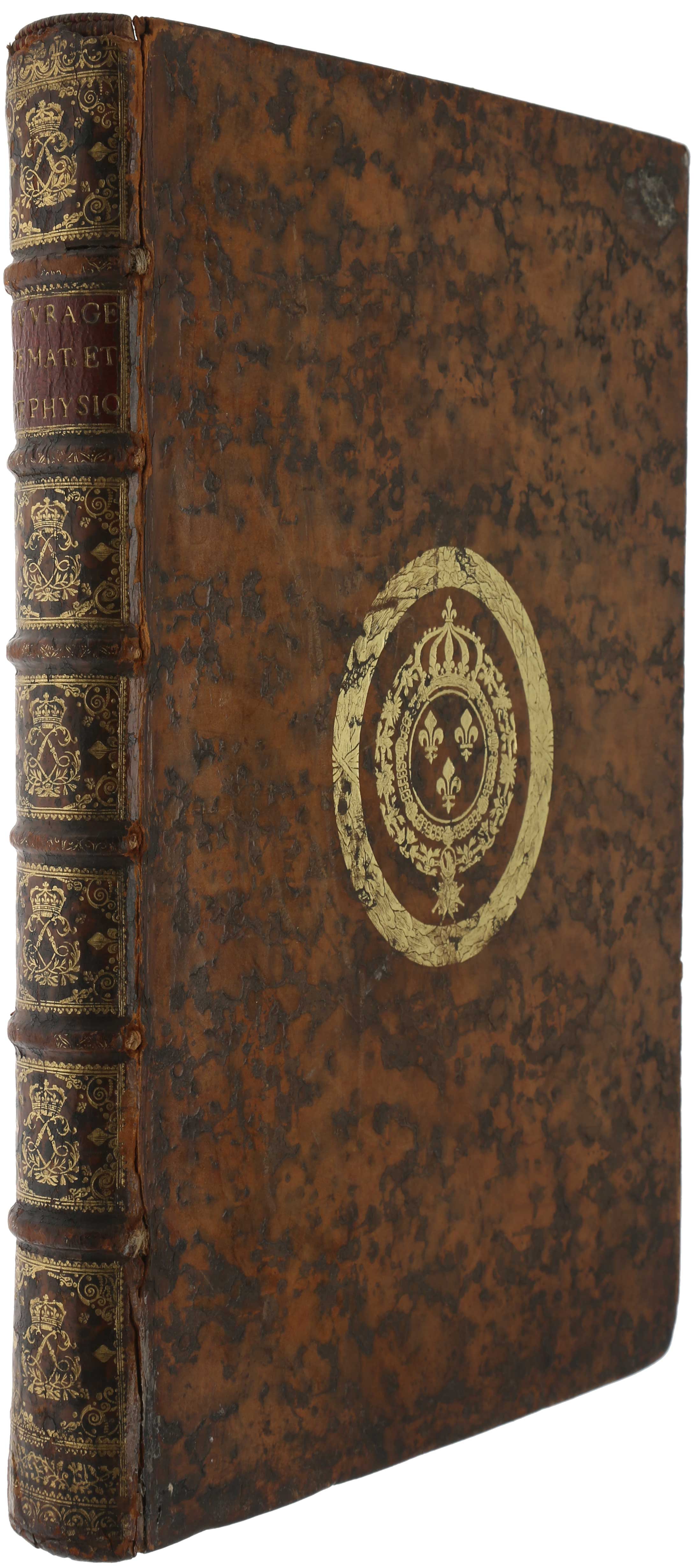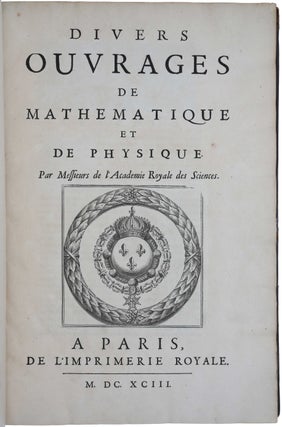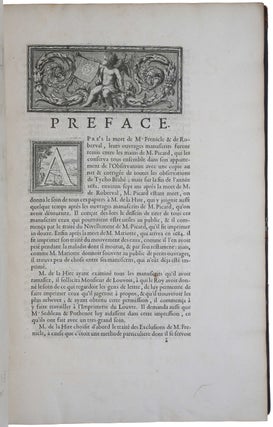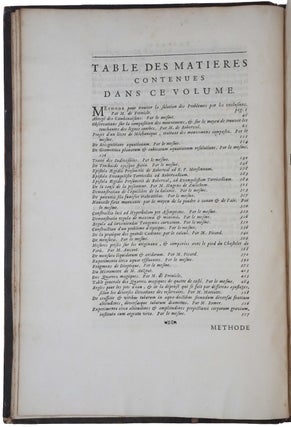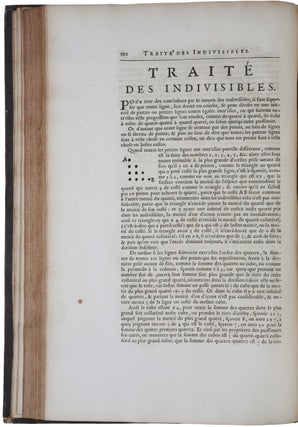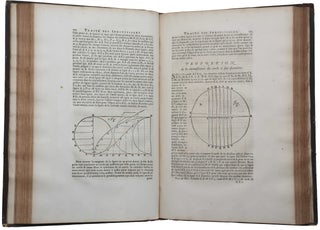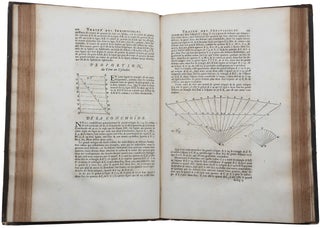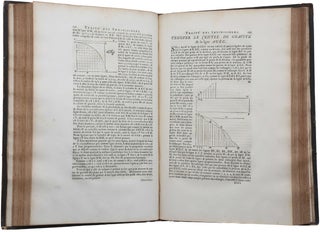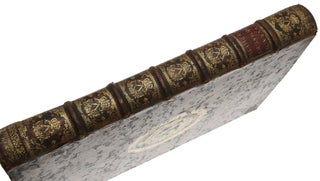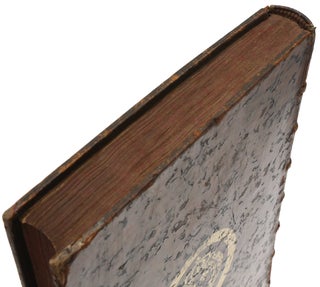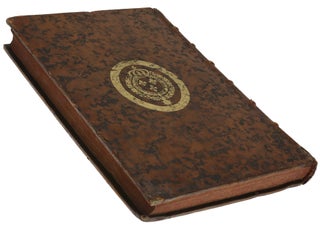Divers ouvrages de mathématique et de physique.
Paris: L’Imprimerie Royale, 1693. First edition of this superb collection of thirty-one treatises by the leading scientists of seventeenth-century France, almost all of which are published here for the first time. This is one of the earliest important publications of the Académie des Sciences, and one of the most magnificent, and the present copy was probably intended for presentation: it is bound in contemporary calf with the arms of Louis XIV on each cover. Founded on 22 December 1666, one of the principal functions of the Académie was to facilitate publication of the works of its members. Frenicle and Roberval were founding members (as was Huygens), and without the assistance of the Académie it is likely that many of their works would have remained unpublished (only two works by Frenicle and two by Roberval were published in their lifetimes). After the death of Frenicle and Roberval in 1675, their books and manuscripts were entrusted to the astronomer Jean Picard; eight treatises by Huygens were also sent to Picard for publication in this collection. After Picard’s death in 1682, publication of the works was brought to fruition by Philippe de la Hire. La Hire also included in the Divers ouvrages five treatises by Picard himself, including an unusual 37-page work on dioptrics, one by Mariotte and two each by Auzout and Rømer. The most important work in the volume is probably Roberval’s Traité des indivisibles, composed around the same time as Cavalieri's Geometria indivisibilibus (1635) but independent of it and published here for the first time. The treatises by Frenicle, a close correspondent of Fermat, treat topics in number theory and related fields. See below for a full list of contents. Gilles Personne de Roberval (1602-75) arrived in Paris in 1628 and put himself in contact with the Mersenne circle. “Mersenne, especially, always held Roberval in the highest esteem. In 1632 Roberval became professor of philosophy at the Collège de Maître Gervais. On 24 June 1634, he was proclaimed the winner in the triennial competition for, the Ramus chair (a position that he kept for the rest of his life) at the Collège Royal in Paris, where at the end of 1655 he also succeeded to Gassendi’s chair of mathematics. In 1666 Roberval was one of the charter members of the Académie des Sciences in Paris … He himself published only two works: Traité de méchanique (1636) and Aristarchi Samii de mundi systemate (1644). A rather full collection of his treatises and letters was published in the Divers ouvrages de mathématique et de physique par messieurs de I’Académie royale des sciences (1693), but since few of his other writings were published in the following period, Roberval was for long eclipsed by Fermat, Pascal, and, above all, by Descartes, his irreconcilable adversary. “Roberval was one of the leading proponents of the geometry of infinitesimals, which he claimed to have taken directly from Archimedes, without having known the work of Cavalieri. Moreover, in supposing that the constituent elements of a figure possess the same dimensions as the figure itself, Roberval came closer to the integral calculus than did Cavalieri, although Roberval’s reasoning in this matter was not free from imprecision. The numerous results that he obtained in this area are collected in the Divers ouvrages, under the title of Traité des indivisibles. One of the first important findings was, in modern terms, the definite integration of the rational power, which he most probably completed around 1636, although by what manner we are not certain. The other important result was the integration of the sine … the most famous of his works in this domain concerns the cycloid. Roberval introduced the “compagne” (“partner”) of the original cycloidal curve and appears to have succeeded, before the end of 1636, in the quadrature of the latter and in the cubature of the solid that it generates in turning around its base … “On account of his method of the “composition of Movements” Roberval may be called the founder of kinematic geometry. This procedure had three applications—the fundamental and most famous being the construction of tangents. “By means of the specific properties of the curved line,” he stated, “examine the various movements made by the point which describes it at the location where you wish to draw the tangent: from all these movements compose a single one; draw the line of direction of the composed movement, and you will have the tangent of the curved line.” Roberval conceived this remarkably intuitive method during his earliest research on the cycloid (before 1636). At first, he kept the invention secret, but he finally taught it between 1639 and 1644; his disciple François du Verdus recorded his lessons in Observations sur la composition des mouvemens, et sur le moyen de trouver les touchantes des lignes courbes … In the second place, he also applied this procedure to comparison of the lengths of curves, a subject almost untouched since antiquity … The third application consisted in determining extrema … “Roberval composed a treatise on algebra, De recognitione aequationum, and another on analytic geometry, De geometrica planarum et cubicarum aequationum resolutione. Before 1632, he had studied the “logistica speciosa” of Viète; but the first treatise, which probably preceded Descartes’s Géométrie, contains only the rudiments of the theory of equations. On the other hand, in 1636 he had already resorted to algebra in search of a tangent. By revealing the details of such works, he would have assured himself a more prominent place in the history of analytic geometry, and even in that of differential calculus … “In 1647 [Roberval] wrote to Torricelli: “We have constructed a mechanics which is new from its foundations to its roof, having rejected, save for a small number, the ancient stones with which it had been built” (p. 301) … around 1669, Roberval wrote Projet d’un livre de mechanique traitant des mouvemens composez … Roberval dreamed, certainly with too great temerity, of a vast physical theory based uniquely on the composition of motions” (DSB). Bernard Frenicle de Bessy (1605-75) was an accomplished amateur mathematician who corresponded with Descartes, Huygens, Mersenne and, perhaps most importantly, Fermat. “Frenicle de Bessy is best known for his contributions to number theory. In fact, Fermat, in a letter to Roberval, writes: ‘For some time M Frenicle has given me the desire to discover the mysteries of numbers, an area in which he is highly versed’ … He solved many of the problems posed by Fermat but he did more than find numerical solutions for he also put forward new ideas and posed further questions” (Mactutor). In “Méthode pour trouver la solution des problèmes par les exclusions, Frenicle says that in his opinion, arithmetic has as its object the finding of solutions in integers of indeterminate problems. He applied his method of exclusion to problems concerning rational right triangles, e.g., he discussed right triangles, the difference or sum of whose legs is given … The most important of these works by Frenicle is the treatise Des quarrez ou tables magiques. These squares, which are of Chinese origin and to which the Arabs were so partial, reached the Occident not later than the fifteenth century. Frenicle pointed out that the number of magic squares increased enormously with the order by writing down 880 magic squares of the fourth order, and gave a process for writing down magic squares of even order” (DSB). In 1666 Jean Picard (1620-82) “was named a founding member of the Académie Royale des Sciences and, even before its opening, participated in several astronomical observations. In collaboration with Adrien Auzout he perfected the movable-wire micrometer and utilized it to measure the diameters of the sun, the moon, and the planets. During the summer of 1667 he applied the astronomical telescope to the instruments used in making angular measurements—quadrants and sectors—and was aware that this innovation greatly expanded the possibilities of astronomical observation. The making of meridian observations by the method of corresponding heights, which he suggested in 1669, was not put into practice until after his death. Yet when the Academy decided to remeasure an arc of meridian in order to obtain a more accurate figure for the earth’s radius, Picard was placed in charge of the operation … it was primarily through the use of instruments fitted with telescopes, quadrants, and sectors for angular measurements that Picard attained a precision thirty to forty times greater than that achieved previously … This increased precision made possible a great advance in the determination of geographical coordinates and in cartography, and enabled Newton in 1684 to arrive at a striking confirmation of the accuracy of his principle of gravitation … “In 1673 Picard moved into the Paris observatory and collaborated with Cassini, Romer, and, later, Philippe de La Hire on the institution’s regular program of observations. He also joined many missions away from the observatory. The first of these enabled him to provide more precise data on the coordinates of various French cities (1672-1674); others, conducted from 1679 to 1681 with La Hire, had the purpose of establishing the bases of the principal triangulation of a new map of France. The results of these geodesic observations were published in 1693 by La Hire [pp. 368-370 of the present work]” (DSB). “In 1692 William Molyneux, who was familiar with [Isaac] Barrow’s Lectiones XVIII, published his Dioptrica nova, which was a practical treatise on lenses and telescopes. He independently arrived at Huygens’s rule for images in thin lenses, though in a slightly different form and stated less generally. In the following year Jean Picard’s posthumous writings on dioptrics [pp. 375-412] also contained a similar rule for thin lenses as well as a series of equations for thick lenses. Picard had read and admired the Lectiones XVIII shortly after it had appeared” (Feingold, Before Newton: The Life and Times of Isaac Barrow (1990), p. 151). Adrien Auzout (1622-91) made a significant contribution to the final development of the micrometer and to the replacement of open sights by telescopic sights ... By the summer of 1666 Auzout and Picard were making systematic observations with fully developed micrometers. In a letter sent on 28 December 1666 to Henry Oldenburg, the first secretary of the Royal Society of London, Auzout explained how his new micrometer, with two parallel wires either of silk of silver, one of which could be moved by a screw, could be used to calculate the diameters of the planets and the parallax of the moon. His treatise Du micrometre (pp. 413-422) appears to be the first published account of Auzout’s work. Of the eight works by Christiaan Huygens (1629-95) in the present volume, all appear here for the first time except for his treatise on gravity, De la cause de la pesanteur, which was first published three years earlier as an appendix to the Traitéde la lumière. Most of these works were reprinted at The Hague in 1731 in quarto format (in three separate volumes). CONTENTS FRENICLE: Méthode pour trouver la solution des Problèmes par les exclusions (1-44); Abregé des Combinaisons (45-64); Des Quarrez magiques (423-483); Table générale des Quarrez magiques de quatre de coste (484-507) ROBERVAL: Observations sur la composition des mouvements & sur le moyen de trouver les touchantes des lignes courbes (69-111); Projet d’un livre de Méchanique, traitant des mouvements composez (112-113); De Recognitione aequationum (114-135); De Geometrica planarum & cubicarum equationum resolutio (136-189) Traité des Indivisbles (190-245); De Trochoide ejusque spatio (246-278); Epistola Aegedii Personerii de Roberval ad R. P. Mersennum (278-282); Epistola Evangelista Torricellii ad Robervallium (283-284); Epistola Aegedii Personerii de Roberval ad Evangelistam Torricellium (284-302) HUYGENS: De la cause de la pesanteur (305-312); Démonstration de l’equilibre de la balance (313-316); De potentiis fila funesque trahentibus (317-319); Nouvelle force mouvante par le moyen de la poudre a canon & de l’air (320-321); Constructio loci ad Hyperbolam per Asymptotos (322-325); Demonstratio regula de maximis et minimis (326-330); Regula ad inveniendas Tangentes curvarum (330-335); Construction d’un problème d’Optique (336) PICARD: De la pratique des grands Cadrans par le calcul (341-365); De mensuris (366-368); Mésures prises sur les originaux, & comparés avec le pied du Chastelet de Paris (368-370); De mensura liquidorum & aridorum (370-374); Fragments de Dioptrique (375-412) AUZOUT: Du micromètre (413-422) MARIOTTE: Règles pour les jets d’eau, & de la depense qui se fait par différens ajustages, selon les diverses élévations des reservoirs (508-516) RØMER: De crassitie & viribus tuborum in aqua-ductibus secundum diversae fontium altitudines, diversaequae tuborum diametros (516-517); Experimenta circa altitudines & amplitudeines projectionis corporum gravium, institute cum argento vivo (517-518).
Folio (365 x 240 mm), pp. [viii, last leaf blank], 518, [2, colophon], with numerous woodcut diagrams and illustrations in text. Contemporary mottled calf with the arms of Louis XIV in the centre of each cover (Olivier 2494, fer 10), and with his monogram in each spine compartment, hinges with some wear and top capital chipped, an entirely unrestored copy in its original state.
Item #4565
Price: $15,000.00

